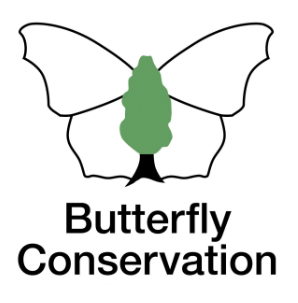Brown Argus
Brown Hairstreak
Chalkhill Blue
Clouded Yellow
Comma
Common Blue
Dark Green Fritillary
Dingy Skipper
Essex Skipper
Gatekeeper
Green Hairstreak
Green-veined White
Grizzled Skipper
Holly Blue
Large Skipper
Large White
Marbled White
Meadow Brown
Orange-tip
Painted Lady
Peacock
Purple Emperor
Purple Hairstreak
Red Admiral
Ringlet
Silver-washed Fritillary
Small Blue
Small Copper
Small Heath
Small Skipper
Small Tortoiseshell
Small White
Speckled Wood
Wall
White Admiral
White-letter Hairstreak
Extinct/rare immigrants
Holly Blue
Celastrina argiolus
General Distribution and Status
The Holly Blue is widespread and common in England and Wales. It is gradually extending northwards into Scotland. It fluctuates widely in numbers giving rise to a regular cycle of a few years, believed to be caused by a parasitic wasp. There appears not to be any significant decline in numbers in the 20th century like most species although many colonies became extinct at a local level but new sites would be colonised quickly (Heath et al.). Since the 1970s there has been an increase in numbers and expansion in range but since 2007 a slight reversal has occurred (Brereton et al.). In Hertfordshire and Middlesex the long-term trend in distribution also appears to be positive although abundance is more variable (Wood, 2016). It appears to be more common in London than in Hertfordshire.
| United Kingdom | Herts & Middx | |||
| Distribution | 1976-2019 | +34% | 1980-2015 | +48% |
| Average 10-year trend | +6% | 2006-2015 | +18% | |
| 2024 since 2015-19 | +5% | |||
| Abundance | 1976-2024 | +174% | 1980-2015 | -56% |
| 2015-2024 | +24% | 2006-2015 | +75% | |
| 2023-2024 | -69% | 2024 since 2015-19 | 0% | |
UK distribution map
UKBMS Species summary
Habitat Requirements
The species is often seen in parks and gardens as well as churchyards, woodland rides and hedgerows. This is the only British butterfly to select different foodplants depending upon the season.
Larval Foodplants
Holly Ilex aquifolium in the spring and Ivy Hedera helix in late summer. Alternative plants occasionally used include Gorse Ulex europaeus, Dogwood Cornus sanguinea, Bramble Rubus fruticosus and Raspberry R. idaeus (Sawford). Dogwood C. sanguinea is perhaps the preferred choice at Shackledell Grassland.
Adult Food Sources
Buddleia Buddleja davidii (93), Bramble R. fruticosus agg. (49), Forget-me-not Myosotis sp. (39), Veronica Hebe x francisana (39).
Historical Records
Gibbs' 1902 survey includes Matthews' record of the species for Norton Green Woods. Foster's 1934 report describes it as 'usually abundant'. A few reports in the 1940s suggest that the butterfly was more numerous than usual. Even in the 1980s from Waterton's survey for 1970-1981 the author writes of the species' fluctuating numbers on about a six-year cycle.
Local Distribution and Abundance
As shown on the map, the butterfly is well distributed in the Stevenage district. 2023 was a very productive year with 227 reports, a record for the TL22 square. Despite a reasonable start in 2024, numbers plummetted in the latter half of the year.

Stevenage (South Fairlands Valley Park) transect 1993-2025
The transect diagram shows fluctuating numbers and a slight negative trend although the exceptional year of 1996 distorts the picture slightly. A cycle of peaks is also apparent (1996, 2004, 2011 and 2015). That great summer of 1996 includes a count of 38 on 3 August with about half of them flying along the hedgerows bordering Shackledell Grassland and Canyon Field as it was then known. 43 sightings were noted in 2023, the second best year ever here with a particularly strong spring brood.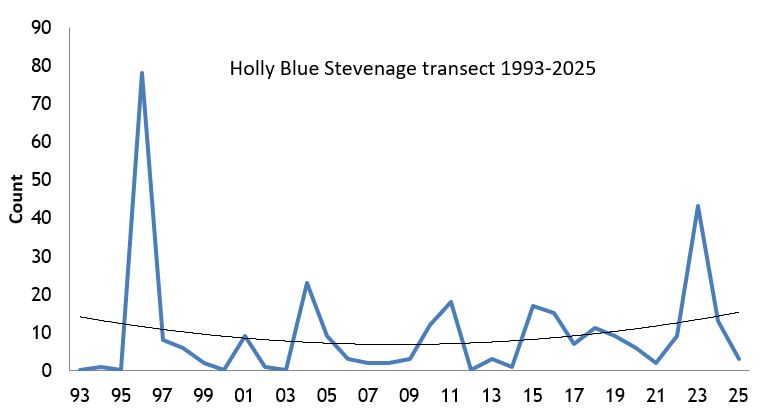

Knebworth Park transect 1996-2010 and 2017-2025
A small negative trend is evident on this transect although as usual with this species numbers vary widely year by year. Only six records reported since the resumption in 2017.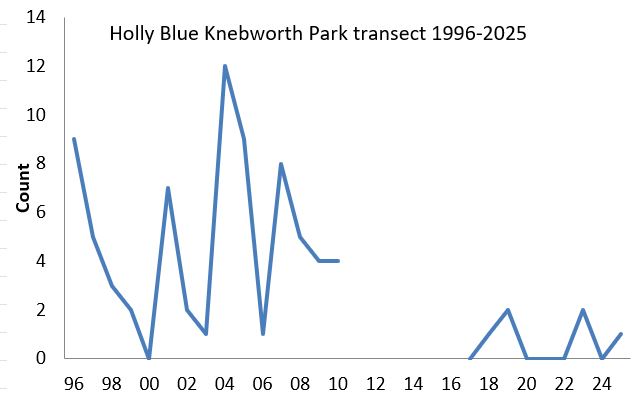
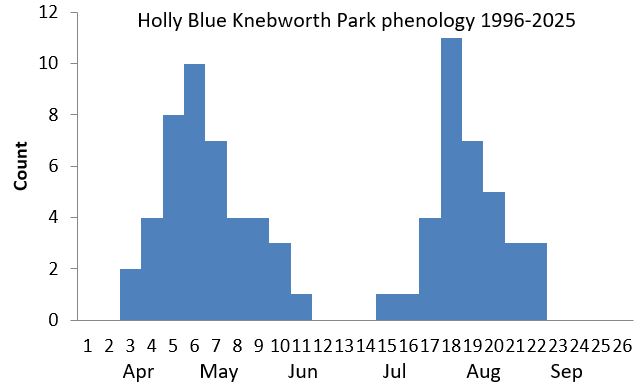
Knebworth Woods transect 2017-2025
11 reports of this species including three in 2023.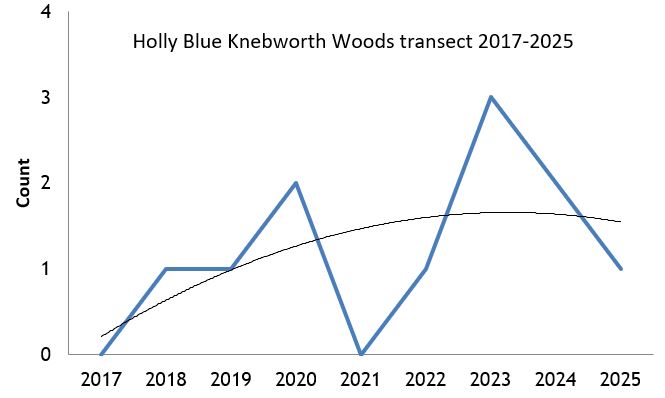
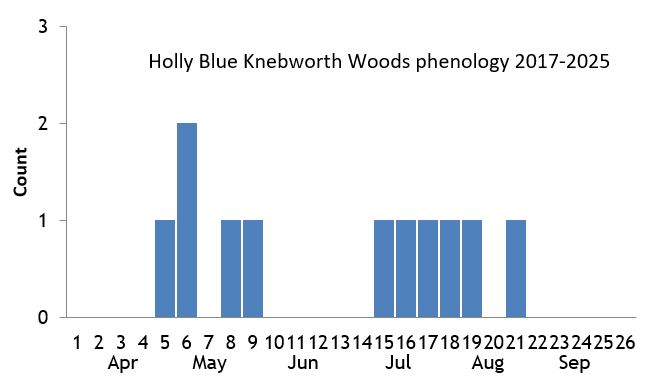
Pryor's Wood transect 2000-2022
Only five records were reported: one each on 30 July 2001, 17 June 2012, 14 May 2017, 7 May 2018 and two on 25 July 2018.Life History
Earliest date: 20 March 2017 near Shephalbury Park
Latest date: 18 October 1997 at Watery Grove
The Holly Blue
produces two generations a year but a partial third brood is sometimes produced as in 1997, 2004, 2014 and 2019 when reports came in for October sightings.
The chart shows that the second brood may be larger but the last few years have indicated that both main broods are broadly similar in abundance. Eggs are laid singly on
unopened flower buds of any number of foodplants in the spring, and ivy in late summer. Larvae feed on the buds leaving holes which is a clue to their presence on neighbouring
buds. Larvae leave the foodplant when fully grown to pupate on the ground. Those which pupate from the late summer brood overwinter in this stage.
Behaviour/Observation notes
Unlike the other 'blues' in Britain, in some ways the Holly Blue behaves more like a 'hairstreak' as it frequents holly and ivy trees. Owing to its strong flight it can be frustrating to get a close-up view but if females are egg-laying then opportunities for taking a photograph are greater. It often basks with its wings half open in the early morning but later in the day they are usually closed. Males sometimes visit the ground on mud or puddles, and animal droppings.
Variations/Aberrations
There are aberrations regarding the amount of blue on the wings and the spot pattern on the undersides but I am unaware of any found in Hertfordshire.
Find out more on the UK Butterflies website
References
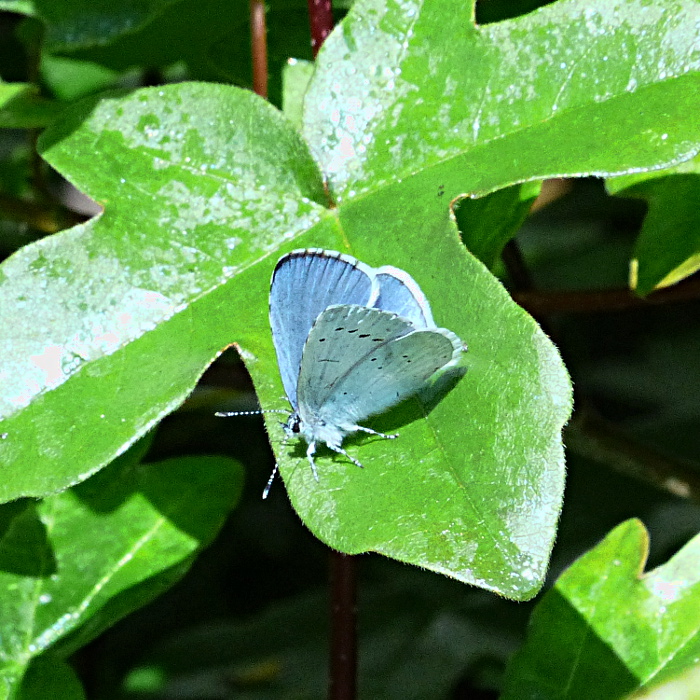
Stevenage 2 May 2019 (m)
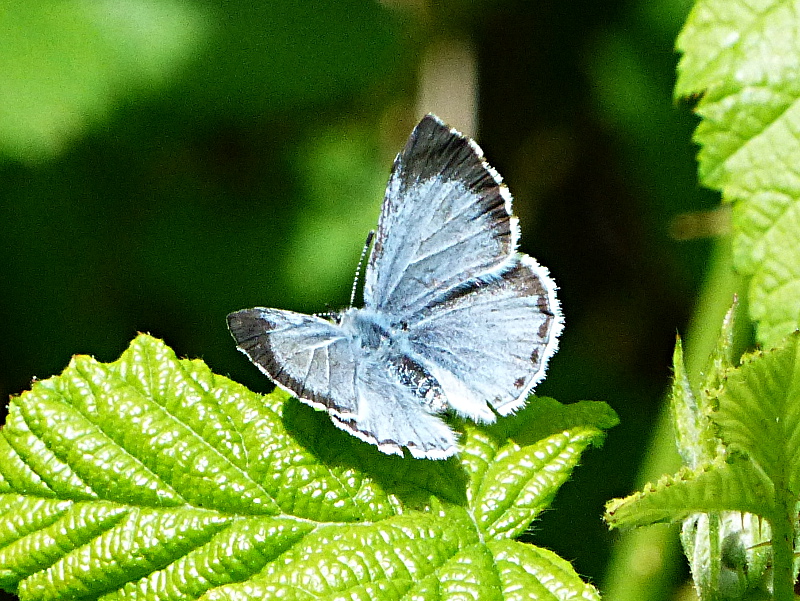
Bareleigh 18 May 2018 (f)
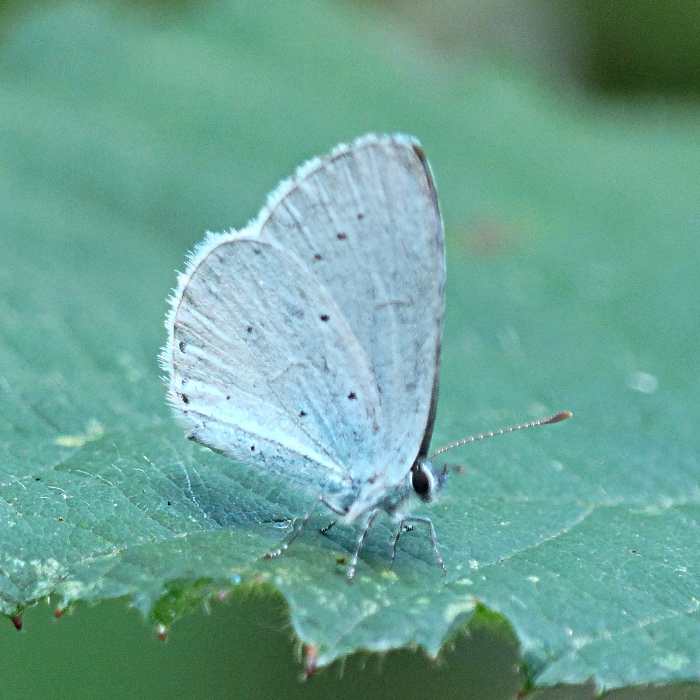
Fairlands Valley Park 29 Jul 2019
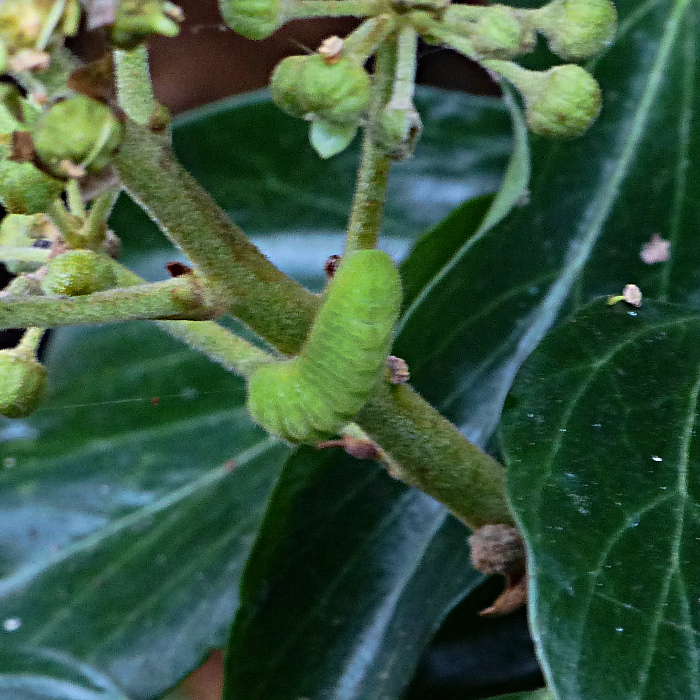
Larva Stevenage 30 Sep 2019
